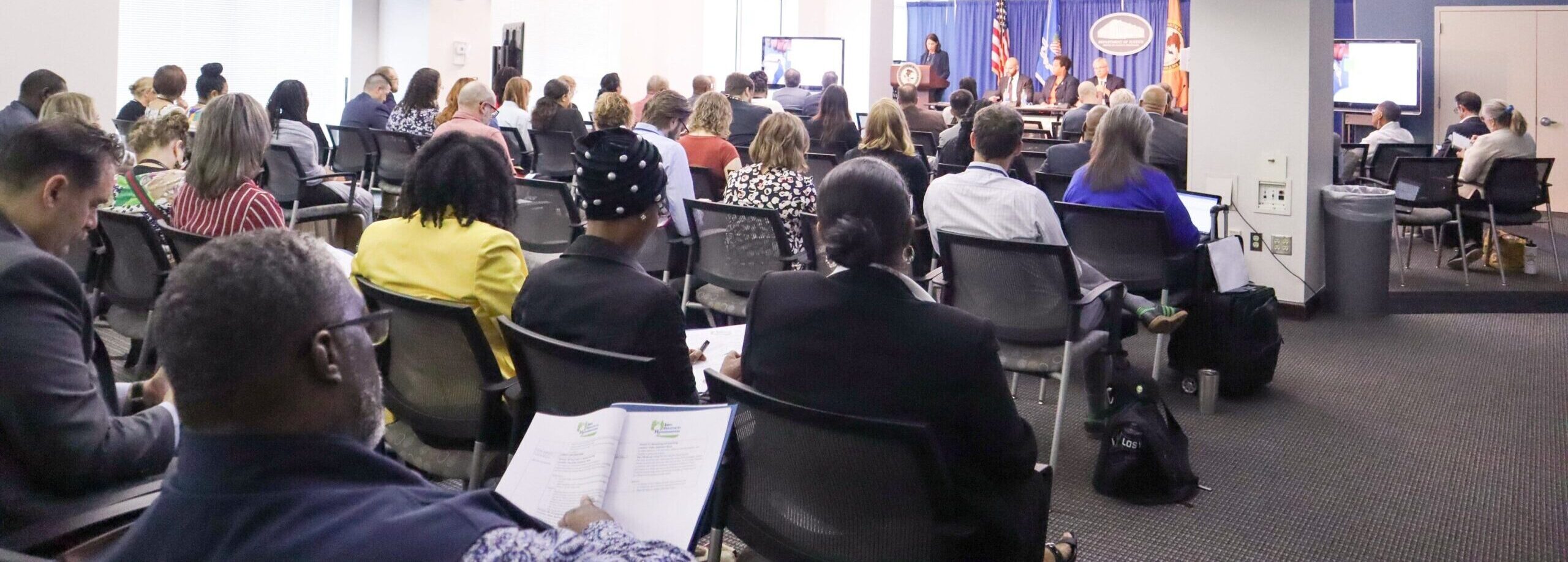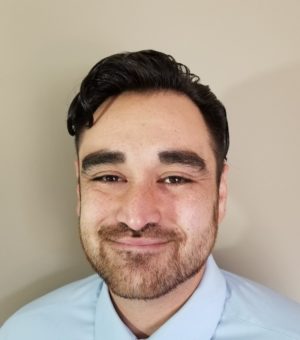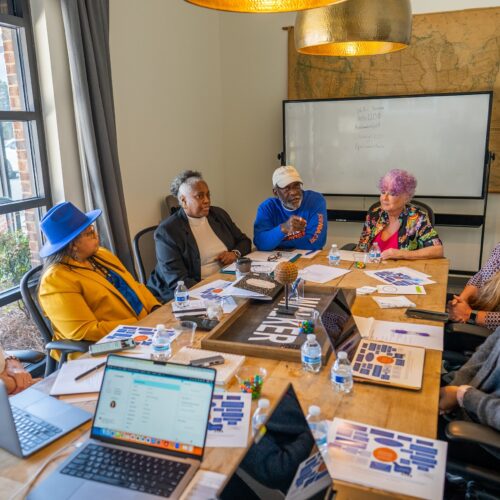
Federal, State, and Local Leaders Gather for First-Ever National Reentry Housing Symposium
State and local officials are increasingly recognizing the need for stable, affordable housing as a solid foundation for successful reentry. However, significant barriers remain to accessing housing as people reenter their communities, such as a limited housing inventory, overly restrictive housing policies, stigma, and limited discharge and reentry services.
To address this critical issue, The Council of State Governments (CSG) Justice Center partnered with the Bureau of Justice Assistance (BJA)—which is a component of the Department of Justice’s Office of Justice Programs—and the U.S. Department of Housing and Urban Development (HUD) to host the first-ever national reentry housing symposium. Focused on a bold new vision of “zero returns to homelessness,” the event brought together federal officials, state and local leaders, reentry housing practitioners, and people with lived experience to discuss and share their efforts to increase housing access for people in reentry. Attendees also spoke about what it would take to realize a vision that challenges states and communities to provide safe and permanent housing for every person returning to their communities from incarceration.
During the event, three major themes emerged to help officials take immediate action toward reducing homelessness and returns to incarceration.
1: No one system can do this work alone.
Effective reentry housing initiatives are built on a foundation of structured collaboration between the justice, housing, health, and behavioral health systems in ways that maximize the limited resources of each. However, silos between systems often halt progress in identifying barriers to housing and leveraging the right resources to reduce them. Throughout the symposium, speakers stressed how cross-system partnerships can help reduce releases into homelessness.
“If we can get everyone in the same boat, moving in the same direction, we can really achieve zero returns to homelessness,” said Annette Chambers-Smith, director of the Ohio Department of Rehabilitation and Corrections.
Across the board, attendees and speakers agreed. Indeed, many made clear that these partnerships can help make supportive housing and services immediately available and create pathways for longer-term housing options for someone reentering the community. For example, in Utah, the Utah Homelessness Council was created by local leaders, homeless providers, philanthropic leaders, and representatives from the Utah Department of Corrections in an effort to identify the necessary resources and interventions to address homelessness. The council, with support from Homebase (a nonprofit focused on supporting communities to build capacity to end homelessness), then developed the Statewide Collaboration for Change: Utah’s Plan to Address Homelessness strategic plan. This plan outlines specific goals and measurable benchmarks to minimize homelessness and coordinate wraparound services in local communities. In particular, goal 3 of the strategic plan will ensure that people exiting the justice system are not discharged directly to homelessness and will receive housing, behavioral health/health care, and other complementary services.
2: People with lived experience must be included in policy change and plans for new housing developments to effectively meet their needs.
Throughout the symposium, attendees consistently expressed the importance of including people with lived experience with both homelessness and the criminal justice system in the fight to end the cycle of homelessness and incarceration. Not only is it the right thing to do, they said, it also benefits officials to learn from the people who have critical expertise in the subject—the ones directly affected by it.
“I experienced prison incarceration four times,” said Dolfinette Martin, housing director of Operation Restoration. “So, I understand firsthand the cycle between incarceration and homelessness accounting for the poorest outcomes and the highest costs.”
Attendees heard from multiple speakers with lived experience who are now leading the field and developing innovative housing solutions to respond to the needs of people experiencing homelessness. What came out of these discussions was a clear directive: community groups and people with lived experience have vital perspectives, and they should be approached in meaningful ways that ensure their critical participation in decision-making processes.
3: Federal agencies are committed to achieving zero returns to homelessness and are important partners as state and local officials work to increase housing opportunities.
Although zero returns to homelessness can seem unattainable, leaders from federal agencies expressed their commitment to the goal throughout the symposium. Federal officials modeled the cross-system collaboration necessary to achieve this important goal, often speaking passionately about the work they are doing to support local efforts across the country and listening to attendees who candidly discussed their needs. HUD officials talked about their comprehensive efforts to reduce unnecessary barriers that people with criminal records face when accessing housing. Representatives from the United States Interagency Council on Homelessness highlighted their recent report, which serves as a roadmap for federal action to provide state and local communities with the resources and guidance needed to reduce homelessness by 25 percent by 2025. And through the Second Chance Pay for Success initiative, BJA spoke of their support of local communities’ efforts to reduce recidivism and connect people leaving prison and jail to housing and supportive services.
BJA and the CSG Justice Center also announced their Zero Returns to Homelessness community of practice that has since begun working with state corrections departments. Participating corrections officials are receiving individualized technical assistance to develop strategies and local implementation plans to increase reentry housing access in their states.
“The unprecedented level of focus and support at the federal level to ensure people have a place to call home when they leave prison or jail gives us hope,” said Charley Francis, deputy program director at the CSG Justice Center. “I’m confident that our federal leaders are committed to solving this issue, and the CSG Justice Center is excited to work alongside them and leaders in states and communities to make zero returns to homelessness a reality.”
For more information and resources on housing and reentry, visit the CSG Justice Center’s housing topic page.
Photo credit: Sarah Kelley, CSG Justice Center
About the author

In response to growing calls for police reform in New Jersey, particularly following the shootings of Najee Seabrooks…
Read MoreWhen returning to their communities from criminal justice settings, people with behavioral health needs face barriers in accessing…
Read MoreNew Hampshire Department of Corrections Commissioner Helen Hanks presents at the Medicaid and Corrections Policy Academy in-person meeting.
Read More Three Things to Know About New Jersey’s Groundbreaking Community Response Legislation
Three Things to Know About New Jersey’s Groundbreaking Community Response Legislation
In response to growing calls for police reform in New Jersey, particularly following the shootings of Najee Seabrooks and Andrew Washington in March and August 2023, a coalition of law enforcement officials, mental health professionals, and community advocates partnered to explore public safety response alternatives.
Read More Assigned to the Cloud Crew: The National Incarceration Association’s Hybrid Case Management for People with Behavioral Health Needs
Assigned to the Cloud Crew: The National Incarceration Association’s Hybrid Case Management for People with Behavioral Health Needs
When returning to their communities from criminal justice settings, people with behavioral health needs face barriers in accessing basic needs—including food, housing, employment, transportation, education, clothing, and substance use and mental health services—which increases their risk of experiencing a crisis.
Read More Meet the Medicaid and Corrections Policy Academy Mentor States
Meet the Medicaid and Corrections Policy Academy Mentor States
New Hampshire Department of Corrections Commissioner Helen Hanks presents at the Medicaid and Corrections Policy Academy in-person meeting.
Read More Taking the HEAT Out of Campus Crises: A Proactive Approach to College Safety
Taking the HEAT Out of Campus Crises: A Proactive Approach to College Safety
The sharp rise in school shootings over the past 25 years has led school officials across the U.S. to take a closer look at ways to keep students safe. For Chaffey College in Rancho Cucamonga, California, a tragic incident at a nearby university hit close to home and spurred campus leaders to revisit their own school’s threat assessments and crisis responses.
Read More From 911 to 988: Salt Lake City’s Innovative Dispatch Diversion Program Gives More Crisis Options
From 911 to 988: Salt Lake City’s Innovative Dispatch Diversion Program Gives More Crisis Options
A three-digit crisis line, 988, launched two years ago to supplement—not necessarily replace—911. Calling 988 simplifies access to services when people are seeking help for themselves or loved ones with suicidal thoughts, behavioral health concerns, or substance use-related crises.
Read More Matching Care to Need: 5 Facts on How to Improve Behavioral Health Crisis Response
Matching Care to Need: 5 Facts on How to Improve Behavioral Health Crisis Response
It would hardly be controversial to expect an ambulance to arrive if someone called 911 for a physical health emergency. And yet, for years, the default responders for a behavioral health emergency have been law enforcement officers, not behavioral health professionals.
Read More









